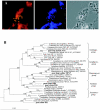Phylogenetic analysis and in situ identification of bacteria community composition in an acidic Sphagnum peat bog
- PMID: 16517660
- PMCID: PMC1393241
- DOI: 10.1128/AEM.72.3.2110-2117.2006
Phylogenetic analysis and in situ identification of bacteria community composition in an acidic Sphagnum peat bog
Abstract
The Bacteria community composition in an acidic Sphagnum peat bog (pH 3.9 to 4.5) was characterized by a combination of 16S rRNA gene clone library analysis, rRNA-targeted fluorescence in situ hybridization (FISH), and cultivation. Among 84 environmental 16S rRNA gene clones, a set of only 16 cloned sequences was closely related (>or=95% similarity) to taxonomically described organisms. Main groups of clones were affiliated with the Acidobacteria (24 clones), Alphaproteobacteria (20), Verrucomicrobia (13), Actinobacteria (8), Deltaproteobacteria (4), Chloroflexi (3), and Planctomycetes (3). The proportion of cells that hybridized with oligonucleotide probes specific for members of the domains Bacteria (EUB338-mix) and Archaea (ARCH915 and ARC344) accounted for only 12 to 22% of the total cell counts. Up to 24% of the EUB338-positive cells could be assigned by FISH to specific bacterial phyla. Alphaproteobacteria and Planctomycetes were the most numerous bacterial groups (up to 1.3x10(7) and 1.1x10(7) cells g-1 peat, respectively). In contrast to conventional plating techniques, a novel biofilm-mediated enrichment approach allowed us to isolate some representatives of predominant Bacteria groups, such as Acidobacteria and Planctomycetes. This novel strategy has great potential to enable the isolation of a significant proportion of the peat bog bacterial diversity.
Figures




References
-
- Basiliko, N., J. B. Yavitt, P. M. Dees, and S. M. Merkel. 2003. Methane biogeochemistry and methanogen communities in two northern peatland ecosystems, New York State. Geomicrobiol. J. 20:563-577.
-
- Chin, K.-J., W. Liesack, and P. H. Janssen. 2001. Opitutus terrae gen. nov., sp. nov., to accommodate novel strains of the division ‘Verrucomicrobia’ isolated from rice paddy soil. Int. J. Syst. Evol. Microbiol. 51:1965-1968. - PubMed
-
- Clark, D. A., and P. R. Norris. 1996. Acidimicrobium ferrooxidans gen. nov., sp. nov.: mixed culture ferrous iron oxidation with Sulfobacillus species. Microbiology 142:785-790. - PubMed
-
- Coates, J. D., D. J. Ellis, C. V. Gaw, and D. R. Lovley. 1999. Geothrix fermentans gen. nov., sp. nov., a novel Fe(III)-reducing bacterium from a hydrocarbon-contaminated aquifer. Int. J. Syst. Bacteriol. 49:1615-1622. - PubMed
Publication types
MeSH terms
Substances
Associated data
- Actions
- Actions
- Actions
- Actions
- Actions
- Actions
- Actions
- Actions
- Actions
- Actions
- Actions
- Actions
- Actions
- Actions
- Actions
- Actions
- Actions
- Actions
- Actions
- Actions
- Actions
- Actions
- Actions
- Actions
- Actions
- Actions
- Actions
- Actions
- Actions
- Actions
- Actions
- Actions
- Actions
- Actions
- Actions
- Actions
- Actions
- Actions
- Actions
- Actions
- Actions
- Actions
- Actions
- Actions
- Actions
- Actions
- Actions
- Actions
- Actions
- Actions
- Actions
- Actions
- Actions
- Actions
- Actions
- Actions
- Actions
- Actions
- Actions
- Actions
- Actions
- Actions
- Actions
- Actions
- Actions
- Actions
- Actions
- Actions
- Actions
- Actions
- Actions
- Actions
- Actions
- Actions
- Actions
- Actions
- Actions
- Actions
- Actions
- Actions
- Actions
- Actions
- Actions
- Actions
- Actions
- Actions
- Actions
LinkOut - more resources
Full Text Sources
Molecular Biology Databases

